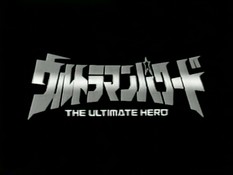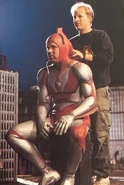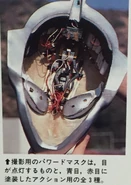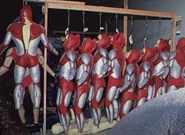| ||
| Why is this bad? |
Ultraman: The Ultimate Hero (also known as Ultraman Powered is a tokusatsu show produced in the United States in 1993 by Major Havoc Entertainment (later renamed Steppin Stone Entertainment) and Tsuburaya Productions with a total of 13 episodes. Following the footsteps of the Australian-produced Ultraman: Towards the Future, this was the second live-action Ultra Series produced outside Japan and the eleventh entry in the franchise overall.
Titled Ultraman Powered for Japanese release, the show was released on home video there on December 17, 1993, and later aired on Tokyo Broadcasting System from April 8 to July 1, 1995. This was the 11th Ultra Series.
However, despite being produced in America, the show was never broadcast there. Although having impressive costume designs, the action was quite weak compared to other installments of the Ultra Series, due to the costumes being fragile. After this series, Tsuburaya has since focused on domestic productions.
Story
The members of WINR (pronounced "Winner") respond when members of the alien Baltan race attack Earth, but the Baltans are only fended off when a gigantic alien, Ultraman Powered, joins with WINR member Kenichi Kai and gives him the power to metamorphose into Ultraman in times of danger. At the end of the first episode Ultraman declares that the Baltans were not completely defeated and that he will remain on Earth to continue the fight.
WINR and Ultraman destroy numerous other monsters, but WINR learns that the Baltans were arranging all the battles to learn Ultraman's strengths and weaknesses. They also learn Kai's secret identity when Ultraman is injured by Dorako and Kai sports an identical wound. In the finale the Baltans unleash their most powerful monster, Zetton. Ultraman separates from Kai and takes on Zetton, but is overwhelmed. Ultraman's color timer is flashing more and more rapidly as he tries to blast Zetton only to have Zetton easily withstand the blasts. He then summons more energy despite the risk to fire a shot at Zetton's ship. This causes the shot to bounce off it towards Z-ton's back but he turns and blocks the shot. However this gives Ultraman an opening and he summons the last of his energy for one final blast that hits Zetton in the back, destroying him. Ultraman then falls over backwards as his energy is completely drained. Before he can perish completely, other members of the Ultra race, appearing as balls of light, arrive and convert Ultraman into a red ball of light so that he can return home.
WINR (Worldwide Investigation Network Response)
- Main article: WINR (Worldwide Investigation Network Response team)
- Captain Russel Edlund - (Harrison Page)
- Theresa Beck - (Sandra Guibord)
- Julie Young - (Robyn Bliley)
- Rick Sanders - (Rob Roy Fitzgerald)
- Kenichi Kai - (Kane Kosugi)
- Ultraman - (Scott Rogers, voiced by Sho Kosugi)
Episodes
- Main article: Ultraman: The Ultimate Hero Episodes
- "On a Mission from M78"
- Ultramen: Ultraman Powered
- Aliens: Powered Alien Baltan
- "Attack Kemular From Behind"
- Ultramen: Ultraman Powered
- Monsters: Powered Kemular
- "A Quartet of Creatures"
- Ultramen: Ultraman Powered
- Monsters: Powered Red King (a female tan and a male red), Powered Chandora, Powered Pigmon
- Guest stars Jeffrey Combs.
- "The Dark Past"
- Ultramen: Ultraman Powered
- Monsters: Powered Telesdon
- Non-Human Characters: The Sun People
- "Monstrous Meltdown"
- Ultramen: Ultraman Powered
- Monsters: Powered Gabora
- "The Dada Effect"
- Ultramen: Ultraman Powered
- Aliens: Powered Dada (A, B & C)
- "Devils from the Crypts"
- Ultramen: Ultraman Powered
- Monsters: Powered Aboras, Powered Banila
- "A Father's Love"
- Ultramen: Ultraman Powered
- Monsters: Powered Jamila
- "The Fires Beneath"
- Ultramen: Ultraman Powered
- Monsters: Powered Zambolar
- "Deadly Starfish"
- Ultramen: Ultraman Powered
- Monsters: Powered Pestar
- "Dino Might"
- Ultramen: Ultraman Powered
- Monsters: Powered Gomora
- "Falling Stars Spell Trouble"
- Ultramen: Ultraman Powered
- Monsters: Powered Dorako, Powered Red King II (it's unknown if this is the same male Red King from before or not)
- "The Final Showdown?"
- Ultramen: Ultraman Powered
- Aliens: Psycho-Baltan
- Monsters: Powered Zetton
Production
Veteran makeup artist and Ultraman fan Steve Wang was briefly involved with the production of the show. He and his team created a miniature suit model of Ultraman which Tsuburaya approved.
Notes & Trivia
- Like Ultraman: Towards the Future, Ultraman: The Ultimate Hero is one of the few Ultra Series not to have an official DVD release.
- Sho Kosugi, who provides Ultraman's voice in the English version, is the father of Kane Kosugi, who plays Kenichi Kai.
- This is the only time that Red King is actually red (as opposed to gold & blue).
- Ultraman Powered's eyes are normally blue, but they change to red when his color timer is red.
- Due to the high cost of producing the costumes, the American Producers were concerned that they'd be damaged in a violent fight scene. As such, Powered has some of the weakest fight choreography in the entire Ultra franchise, consisting mostly of the actors nudging each other and SFX attacks with minimal physical contact. This is one of the key downsides to this series.
Theme Songs
Openings
- "Ultraman Powered" : The Opening theme. The US version uses an instrumental version.
- Lyrics - Goro Matsui
- Composer - Suzuki Kisaburo
- Arranger - Tatsumi Yano
- Singer - Tatsuya Maeda
TV sized
Endings
- "Somewhere in this Universe ": The first ending theme.
- Lyrics - Goro Matsui
- Composition - Suzuki Kisaburo
- Arrangement - Tamimi Yano
- Singer - Tatsuya Maeda
- "STARLIGHT FANTASY": The second ending theme.
- Lyrics - MoriYuki KoreSusumu C
- Composer - YoMinoru Akihiro
- Arranger - Y2
- Singer - Hitomi Sudo
TV sized
Gallery
Behind the Scenes
Media
The show spawned a video game, called Ultraman Powered, released for the 3DO Interactive Multiplayer.
Cameo
- Mega Monster Battle: Ultra Galaxy (2009), Powered along with other M78 Ultra Warriors fight against the evil Ultraman Belial. However it must be noted that despite appearing in this movie, he did not appear in the Ultraman Mebius series. The Ultraman Mebius series is the series that establishes which Ultras are members of the "Ultra Brothers."
External links
- Template:Imdb title
- Ultraman: The Ultimate Hero episode guide
Template:Shows and Films











